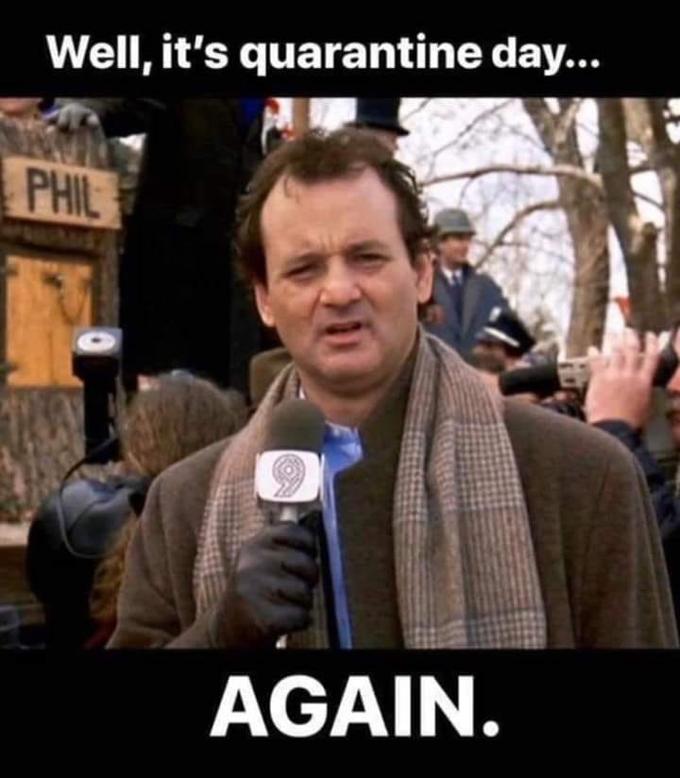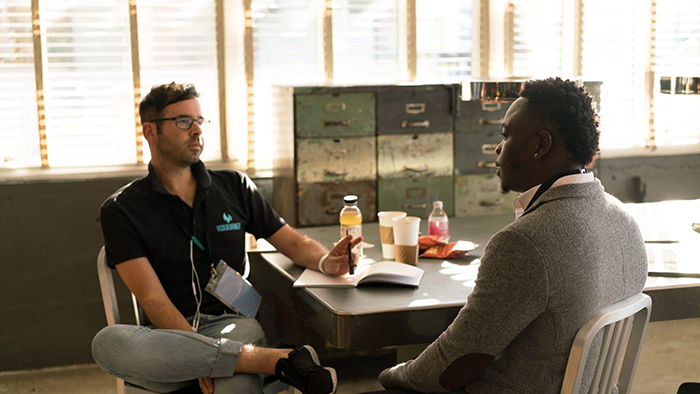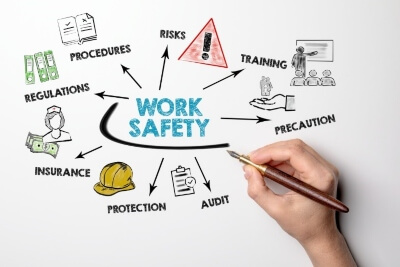Quick question, dear readers, remember the 1993 classic film “Groundhog Day” with Bill Murray?
No matter what the main character does, he wakes up back in time and starts Groundhog Day all over again? The film more or less walks through the 5 stages of grief and highlights the mental health challenges one could expect to go through while trapped in a never-ending hopeless circle of despair.
Sound remotely familiar to you?

Our current situation of lockdowns, travel restrictions, working from home, and all the related issues associated – such as kids frustrated with online learning and stage 5 cabin fever – makes you want to just “GAAAAHHHHHHH.”
Phew, I feel better; let’s continue…
Now I am aware that we as a training provider have been pushing the importance of controlling psychosocial hazards resulting from this unique situation throughout our courses, especially during JHSC certifications throughout the entirety of this pandemic. This has led to many great conversations about some of the challenges and creative solutions employers have implemented.
What I thought we could talk about today are a few common themes that routinely pop up from participants. Before we continue, make sure you watch the “Grief Giraffe” video, as we can use him as an example as we move along.
So now you have had a good laugh, you’re pumped and excited, so let’s continue.
Psychosocial Hazards
On speaking with many groups groups of participants about what type of psychosocial hazards seem to be the most prevalent from their perspective, there are three that really seem to emerge in these discussions. The big one is always social isolation.
Now in full disclosure, I cannot say that this truly affects me that much. I am, by nature, a homebody – an introvert. So the fact that I am out less and can focus on my work from my own “habitat,” as my wife puts it, has its pros.
I am less stressed about the commutes that are usually required, I can be here to sign for packages for my slight online shopping addiction, and more importantly, I am available to watch the little ones in case of illness. I’m not saying I don’t miss going out to client facilities because I really do, but being at home hasn’t quite lost its appeal for me yet.
As mentioned in the last post, Working From Home Checklist for 2021, I only started working from home in January. To be honest, I think there are still a fair number of us happy with the current work set up. The stress and anxiety come with the thought of returning to the status quo of the times before.
Will we be given a transitionary period to acclimatize back to being around people all the time?
Not too sure.
That being said, I know I am NOT in the majority here. Clients and participants seem to highlight the extroverted workforce’s requirements (probably because they are the vocal ones ☺). Extroverts recharge their personal batteries with social interaction and social contact.
The highlight of going to work is, yes, doing a good, nay, great job, and getting to be around others. We can bounce ideas off each other, get inspiration and motivation through informal meetings and discussions. We can even compare our productivity rates to others to ensure we are working as hard as we should be… but alas, that’s all gone now.
Our workers sit in their living rooms, alone, in front of a laptop, probably without appropriate clothing, miserable. So in terms of hazard recognition, social isolation is a big one.
Self-Care
As an extension to the point mentioned above, in regard to both our introverts and extroverts, self-care is another concern that gets voiced. Are we still taking care of ourselves?
Now, if I asked you individually, you would probably think so. But the School Mental Health Ontario (SMHO) has a poster that lists some things to consider. Yes, it’s for students working from home, but the logic still applies to us as well. As adults, we aren’t growing; our bodies are in decline, so we should probably be more diligent about it than the kids!
One element of self-care is consistently eating a balanced diet. We need to fuel ourselves properly to be able to perform at our best.
Unfortunately, unless you order delivery, the quick pop out of the office for lunch isn’t going to happen; we have to make an effort to prepare something other than a snacky snack.
Our bodies need adequate sleep, but flex hours are becoming the norm without the same obligations on our time. If you are helping kids with their school, then work gets bumped to, and sleep can suffer. Even the pandemic and associated anxieties can cause us to lose sleep.
Our bodies need to stay hydrated – and this one I am bad for. Normally while presenting a course, I down a ton of water as it’s always the easiest thing to bring with me, and filling up my bottle can give me a break to get up and move. At home, I find I am not making the same effort. Coffee is my primary liquid while teaching these days.
We also need to remember to move. Holding our muscle groups in a static position all day isn’t the most ergonomic friendly activity we can engage in. When we were at our workplace, we were forced to physically move around at work, even commuting gets us up and out of the house, but now we are supposed to stay in, leading to sedentariness.
I have 12 stairs and 14 feet to get to work every day; some of you may have even less.
We need to remember to enjoy what we do in life and at work; remember I did use that whole “Groundhog Day” comparison, which shows it is definitely a challenge at times.
Social interaction and our newfound isolation prove to be a massive obstacle in our need to connect to our coworkers and family. Ultimately we need some sort of self-auditing tool to keep us in line.
Working from home, absent constant video calls, eliminates our societal norms being reinforced through the observation by others. How is your employer encouraging you to pause and reflect on their worker’s level of self-care? We need to ensure we repeat the good stuff and put a moratorium on the bad.
Mental Health Workplace Resources

Employers and JHSC’s are great resources for information; however, working from home or reduced staff in the workplace has changed the fundamental structures relied on for hazard recognition, assessment, control, and evaluation.
Usually, a poster on a health and safety board would advertise an EAP program’s availability.
Now all we get is an email blast?
Perhaps, but again without any source to trigger any need of it – such as it being mentioned to you by a colleague or manager, it will continue to be one of the most underutilized parts of the benefits package. What other supports does your employer offer?
One client told our group about digital coffee breaks. Those who do miss the social aspect can sign up for paid time breaks to recharge batteries – it turns out it boosts productivity levels too!
There is no right or wrong answer here, just what works for your team, and your organization.
The fact that there are resources out there cannot be forgotten about. A lot of relationships require maintenance, and without social contact, we can forget about people. Not everyone is the childhood bestie where a year can go by, and you can pick up from where you left off.
Safety Culture
An employer and JHSC work together to improve the workplace’s safety culture; it would be a shame if all of those efforts were for naught due to our shift in practices for infection prevention and control.
That being said the employee should make an effort to meet the employer halfway.
Think about the duty to accommodate; it can’t happen unless you ask for help. The OHSA, however, does have an exception for the onus of certain items like domestic violence – something the media has been covering with Covid-19 – S. 32.0.4:
“If an employer becomes aware, or ought reasonably to be aware, that domestic violence that would likely expose a worker to physical injury may occur in the workplace, the employer shall take every precaution reasonable in the circumstances for the protection of the worker”
Promoting wellness is done through programs at work, as mentioned above. Remember, we aren’t necessarily going through this alone, family members are a great resource. They provide social contact (sometimes too much, I’m aware of the new divorce rate), but they can also act as a litmus test for our own mental health.
Being told you are moody or curt? Being told that your motivation has dropped? What about the kids, if applicable? Those little critters don’t filter anything they say – and working alone for some time has its consequences – don’t be offended if you are told your behaviour/sense of humour is a little… how should I say… off.
The good news, however, you have recognized an issue!
What’s next?
Assessment, control, and evaluation, of course! No different than any other hazard in your workplace.
So what can we do about it? Did Bill Murray let Groundhog Day get him down?
Well, yes, at first, but then he had fun with it!
As a parent with kids learning from home we were given resources to us, but why can’t we use them for us? Again the SMHO gave us some ideas.

Can employers encourage some silliness with a digital game of emotional charades, gratitude moment, kindness jar, or show and share? Of course, they can. Suggest If this challenges your current culture, then excellent!
This is a perfect time for new beginnings.
We brought our work home, so inevitably our home will spill a little into work. I now have a practice that requires all pets on the screen to be introduced to the group just as participants do. Let’s be honest, they are part of the meeting too – and it’s not their fault they were born with fur or feathers.
Something as simple as that opens up meetings to a level that sometimes is ignored – the human element.
We are workers, yes, but we are people too – and people have needs to fulfill outside of making money and getting the work done, in talking about the intrinsic rewards that we get from our jobs that just can’t be quantified.
So whether you plan on auditing yourself or coworkers’ mental health, try out some fun mental health exercises at home, encourage people to talk with others virtually, take advantage of social media to reach out – whatever.
Psychosocial hazards have always been a factor in our workplaces, but the dynamics have changed the game; workers still have to be given information, instruction, and supervision and be informed of the hazards to protect their health and safety (that’s right, I snuck in a little OHSA S.25 for you there).
That being said, whichever mental state you find yourself in while reading this, let’s think back to the “Grief Giraffe” – it turns out his feet wouldn’t let him drown. He just has a new hazard to contend with. New hazard? We all know what to do next…
Make good choices.
Geoff Rowatt
Health & Safety Trainer | CHRP | CHRL





